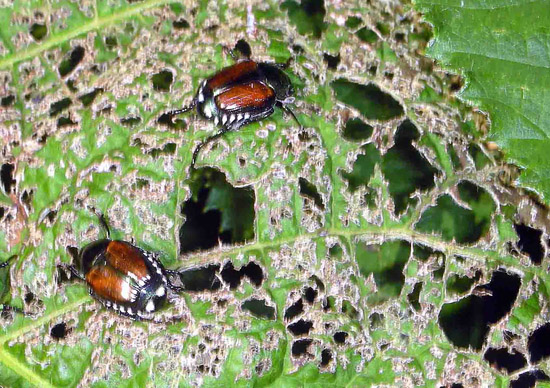Issue 10, June 28, 2013
Japanese Beetle
Thanks to a variety of readers that responded to the article last week on Japanese beetle. I can now report that they have been present in southern and central Illinois since the third week of June and were seen in LaSalle and Will Counties on June 24. With the warm temperatures of the past week, they should have emerged in the rest of northern Illinois by now.
Typical emergence pattern for most insects is that the males emerge a few days before the females. About a week after the adult Japanese beetles become numerous, "balling" is likely to occur. When a female Japanese beetle is emerging from the soil, males gather at the location. As she emerges, they are attracted to her, crawling on top of each other. The result is a ball of 25 to 200 Japanese beetles, frequently about the size of a golf ball. They are most noticeable on closely mowed turf, so most reports come from golf courses.
Beetles mate, and the females tunnel into the turf to lay eggs. These eggs hatch into white grubs that feed on the turf's roots, resulting in browning and dieback of the turf in late summer and fall. Female beetles are strongly attracted to moist, actively growing turf, so stopping or reducing irrigation during July results in reduced egg-laying, with fewer grubs. The beetles go to the neighbors' moister, greener lawns to lay their eggs. Typically, unwatered lawns do not have enough white grubs to warrant insecticide application.
Male and female beetles are similar in appearance, being stocky, 3/8- to 1/2-inch-long, metallic green beetles with copper-colored wing covers. They are present in high numbers for about 6 weeks. They feed on the foliage and flowers of a wide range of plants, being most common on smartweed, crabapple, linden, birch, willow, rose, grape, apple, peach, and brambles. They do not feed heavily on needled evergreens, ashes, magnolias, oaks, and maples other than Japanese maple. They feed during the day at the top of the plant on the leaf's upperside--they appear to like sunshine. Individuals typically fly to another food plant every 3 days. These flights tend to be long, from 3/4 to 1-1/2 miles.

Japenes Beetle Adults and Two type of Damage on Grape
The adults feed through the upper epidermis and mesophyll, leaving the lower epidermis intact. Initially, damaged leaves are whitish but soon turn brown as the exposed lower epidermis dries and turn brown. This type of damage is called window feeding. Heavy feeding results in holes in the leaves and can progress on favored hosts to skeletonization, with only the major leaf veins remaining.
Beetles are attracted to previously attacked plants. Homeowners can greatly reduce damage by handpicking, particularly for the first week or two after beetle emergence. Use a wide-mouthed jar (such as a peanut butter jar) containing rubbing alcohol or a detergent and water mixture. Hold the jar under a beetle, poke it, and the beetle will fold its legs and fall into the jar, being killed by the alcohol or drowning in the soapy water. Doing this daily or every other day for the first couple of weeks results in plants with little damage compared to the neighbors' plants. Throughout the rest of the season, beetles will be more attracted to the plants next door.
Heavily attacked ornamental plants in obvious locations in the landscape can be sprayed with carbaryl (Sevin), cyfluthrin (Tempo), or other pyrethroid. An application typically controls the beetles for about 2 weeks. Because the beetles are out for about 6 weeks, three applications are needed. Due to the repeated applications and large plants that are commonly attacked, the use of insecticide can be reduced by spraying only plants where the damage is very noticeable. Plants in less obvious parts of the landscape and large trees can go untreated because the damage will be less noticeable. The beetles are so numerous and mobile that the beetles on the untreated plants make little difference in the number of beetles attacking treated plants or the amount of turf injury by the subsequent white grubs.
Systemic insecticide application is also effective, with imidacloprid (Merit, Xytect, Optrol) applied as a soil injection or soil drench being the most common method of application. The insecticide will move into the foliage within a couple of weeks. Imidacloprid does not typically move into the flowers of rosaceous plants such as rose, crabapple, and hawthorn, but can be found in linden flowers. Imidacloprid has been linked in some studies to colony collapse disorder (CCD) in honey bees, so avoid use on trees and shrubs where the insecticide enters the flowers. As the imidacloprid remains in the plant for almost one year, one cannot avoid movement into the flowers through application timing.
Author:
Phil Nixon